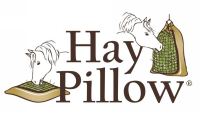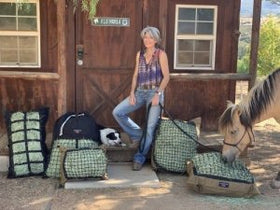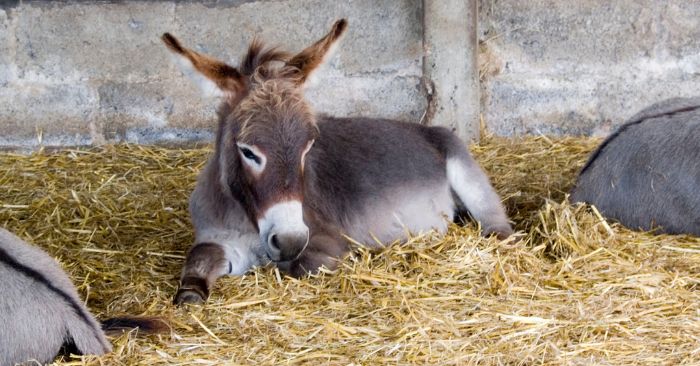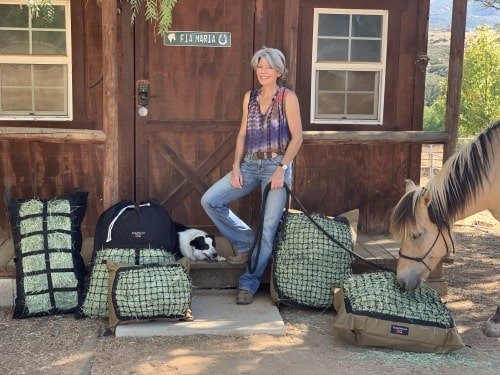Feeding Donkeys Straw and Hay: Q & A with The Donkey Sanctuary

What is Straw?
Why Feed Straw to Donkeys?
What Kind of Straw Is Best?
Wheat straw is more fibrous than barley straw and more difficult to chew. We would usually only recommend feeding it to younger donkeys for this reason. Wheat straw doesn’t perform very well as a bedding material so is not generally a first choice.
Oat straw is higher in calories than barley or wheat straw, it needs to be fed with caution to avoid weight gain so may be a good option for slimmer donkeys. Oat straw is also highly prized by the feed manufacturers so it is often in short supply and more expensive.
How Much to Feed?
We know, from research conducted here at The Donkey Sanctuary, that donkeys need to eat approximately 1.5% of their own bodyweight per day in dry food. Straw contains very little water and is approximately 90% dry matter. For most average-sized donkeys this equates to roughly 2-3 kg of fiber per day. It isn’t necessary to get too hung up on the numbers and start making complicated calculations as providing an ad-lib fiber-based diet will ensure your donkeys are getting enough to eat in terms of bulk. The amount can be adjusted according to the time of year. Donkeys burn more energy trying to stay warm in the winter and often end up losing a bit of weight. During the summer there are more nutrients in the grass and without monitoring your donkeys' weight can often end up putting on a bit of weight.
What About Grass, Hay and Haylage?
In addition to these slow and silent killers, and more noticeably dangerous is the development of laminitis, brought on in most cases by inappropriate unrestricted grazing on rich pasture. A lack of fibrous forage such as straw may also lead to donkeys seeking alternative fiber sources leading to problems with wood chewing (including fencing and stables) and eating of inappropriate bedding, plants and trees.
Grass or hay/haylage should make up approximately 25-50% of the diet depending on the time of year. Donkeys don’t generally need to eat grass alongside hay/haylage for a large part of the year when nutrients are fairly high in growing grass. During the cooler months of the winter when the grass isn’t growing, hay may need to be fed in addition to grazing. Depending on a donkey’s condition hay/haylage could make up to 50% of the diet. We wouldn’t generally recommend feeding a larger proportion of hay/haylage than straw, even in young growing donkeys. Exceptions to this may be late-stage pregnancy or lactating mares.
What About Colic?
Are There Any Types of Donkeys That Shouldn’t Be Fed Straw?
For these ‘dental’ donkeys we don’t recommend feeding straw, hay or haylage but instead recommend pre-chopped fibers known as ‘chaff’ or ‘chop’. Chaff/chop products are easier to pick up and chew and will ensure the donkey can actually consume enough to stay healthy and avoid the risk of choking on partially chewed food.
Donkeys on box rest may need their diet adjusting, please contact your vet for advice.
What Is Forage Testing and Why Should I Have It Done?
Learn how to test straw or hay, where to send the sample and how to calculate NSCs using the results. Related links are provided to guide you through the process.
In Closing
Learn more about:
- The Sanctuary's mission and donkey care: The Donkey Sanctuary
- Feeding your donkeys: Find comprehensive guides, FAQs and advice for donkeys of all ages.
Recommended Slow Feed Solutions to Contain Straw & Reduce Waste
Helpful Resources
- Feeding Miniature Horses & Donkeys: Why Slow Fed Forage Is Best
- How & Where to Test Your Horse's Hay & Interpret Results
- Can Horses Eat More Hay Without Weight Gain? The Surprising Factors
- Sugar Content of Pasture & Hay: Q & A with Katy Watts, Founder of Safergrass.org
- 7 Easy Ways To Help Prevent Equine Colic
- A Safer Always Have Hay Source – Mature Grass Hay
- How to Introduce & Incorporate Free-Choice Forage: An Action Plan
- 9 Benefits of Slow Feeding Horses - Get Slow Feed Savvy
- Safety Tips for Choosing & Using Slow Feeders for Horses
- Equine Gastric Acid - 12 Facts You May Not Know







2 Comments -
Hay Pillow Inc • -
Jane Hendrix •
Hi Jane,
If they are being fed meals of grass hay, they will certainly scrounge for any scraps that end up in the sand between meals.
Check out these blog posts:
7 Easy Ways To Help Prevent Equine Colic
Sand Colic – The Surprising (Simple) Cure & Prevention
I am considering using haypillow ground slow feeders for two quite overweight donkeys. Do you have information specific to donkey feeding?
My paddock is sand. I am concerned about them getting too much sand trying to recover hay that is dropped. Do you have any experience with this?
Thank you.